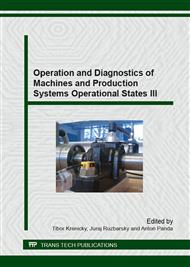p.243
p.253
p.262
p.270
p.278
p.286
p.294
p.302
p.311
Bearing Rings Turning and the Impact of this Process for Resulting Durability of Selected Cutting Materials Durability
Abstract:
Essential factors of each new discovery or piece of knowledge in science are predetermined, prepared and realized experiment. Every successfully realized experiment with obtained outputs and measurements indicates the gauge of asset that has been achieved by its execution. After analyzing of outputs final dependencies can be described that generalize whole experiment and allow entire process to be analytically identified. The production of bearings is very difficult process. Especially production of bearing rings is very complicated. Optimization of this process means significant savings for the company. Bearing rings are produced by turning. One of the most important parts of the turning process is cutting tool. On the base of cutting tools are determined many factors for example: quality, price, cutting speed, etc. All these factors of cutting tools are the only consequence of these cutting tools durability. Cutting tool durability determines its cutting properties and machinable ability. Specification of tool wear by means of calculation is very difficult. Durability of cutting tools is defined in standard ISO 3685. In standard ISO 3685 is defined T-vc dependence for different cutting materials and standard included process evaluation of tool durability for cutting materials made of high speed steel, sintered carbide and cutting ceramic. The article describes evaluation of T-vc dependence on the selected type of cutting materials and theirs comparison with measured values T-vc dependence that are defined in standard ISO 3685.
Info:
Periodical:
Pages:
278-285
Citation:
Online since:
October 2015
Authors:
Keywords:
Price:
Сopyright:
© 2016 Trans Tech Publications Ltd. All Rights Reserved
Share:
Citation:


